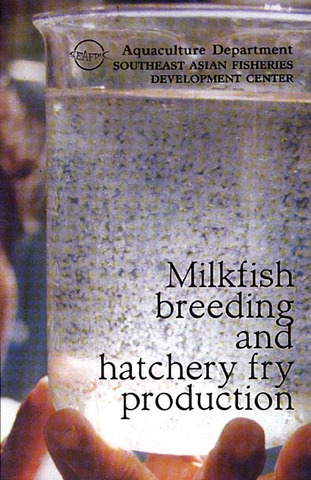Fisheries biology of milkfish (Chanos chanos Forskal)
| dc.contributor.author | Garcia, Luis Maria | |
| dc.contributor.editor | Tanaka, H. | |
| dc.contributor.editor | Uwate, K. R. | |
| dc.contributor.editor | Juario, J. V. | |
| dc.contributor.editor | Lee, C. S. | |
| dc.contributor.editor | Foscarini, R. | |
| dc.date.accessioned | 2011-06-22T09:35:19Z | |
| dc.date.available | 2011-06-22T09:35:19Z | |
| dc.date.issued | 1990 | |
| dc.identifier.uri | http://hdl.handle.net/10862/331 | |
| dc.description.abstract | Milkfish (Chanos chanos Forskal) is one of the most important food fish species in the world. In Indonesia, Taiwan and the Philippines, more than a quarter of a million tonnes of milkfish are harvested annually in brackish ponds, contributing roughly 60% of the total fish production from aquaculture in Southeast Asia. This tremendous level of production from a single fish commodity is projected to further increase in the coming years to meet the dietary protein needs of an ever-growing population in Southeast Asia. To address vital research gaps afflicting the milkfish industry, research has correspondingly intensified over the past 15 years particularly in the Philippines, Taiwan and Hawaii. Results of such research projects have widespread application not only among Southeast Asian nations but also among many untapped areas in the Pacific, the Middle East, Africa and Central America where milkfish culture is feasible. A sound approach to initiate a milkfish aquaculture project is to have an adequate knowledge of the basic biology of this species. Several researchers have presented in great technical detail some of these biological aspects at numerous symposia (Juario et al., 1984, Lee, Gordon and Watanabe, 1986). This paper will therefore summarize in moderate detail some recent additional information on several aspects of milkfish biology: taxonomy, distribution, life history and habitat, food and feeding habits, growth, reproduction and tolerance to environmental conditions. Aside from increasing our understanding of milkfish, it is hoped that this short review will goad others to undertake further scientific research on many unknown aspects of the species, thus contributing to both the quality and the quantity of milkfish served on our dinner tables. | en |
| dc.language.iso | en | en |
| dc.publisher | Food and Agriculture Organization of the United Nations, South Pacific Aquaculture Development Project | en |
| dc.relation.ispartof | In: Tanaka, H., Uwate, K.R., Juario, J.V., Lee, C.S., Foscarini, R. (eds.). Proceedings of the Regional Workshop on Milkfish Culture Development in the South Pacific, 21-25 November 1988, Tarawa, Kiribati. Suva, Fiji: Food and Agriculture Organization of the United Nations, South Pacific Aquaculture Development Project. pp. 66-76 | en |
| dc.relation.uri | http://www.fao.org/docrep/field/003/AC282E/AC282E04.htm#ch3.2 | |
| dc.subject | Philippines | en |
| dc.subject | milkfish | en |
| dc.subject | Chanos chanos | en |
| dc.subject.lcc | VF SP 122 | |
| dc.title | Fisheries biology of milkfish (Chanos chanos Forskal) | en |
| dc.type | Conference paper | en |
| dc.citation.spage | 66 | |
| dc.citation.epage | 76 | |
| dc.citation.conferenceTitle | Proceedings of the Regional Workshop on Milkfish Culture Development in the South Pacific, 21-25 November 1988, Tarawa, Kiribati | en |
| dc.subject.asfa | food fish | en |
| dc.subject.asfa | milkfish culture | en |
| dc.subject.asfa | biology | en |
| dc.subject.asfa | fishery biology | en |
| dc.subject.asfa | taxonomy | en |
| dc.subject.asfa | geographical distribution | en |
| dc.subject.asfa | life history | en |
| dc.subject.asfa | habitats | en |
| dc.subject.asfa | feeding habits | en |
| dc.subject.asfa | food preferences | en |
| dc.subject.asfa | reproduction | en |
| dc.subject.asfa | tolerance | en |
| dc.subject.scientificName | Chanos chanos |
このアイテムのファイル
| ファイル | サイズ | フォーマット | 閲覧 |
|---|---|---|---|
|
このアイテムに関連するファイルは存在しません。 |
|||
このアイテムは次のコレクションに所属しています
-
Conference Proceedings [298]



